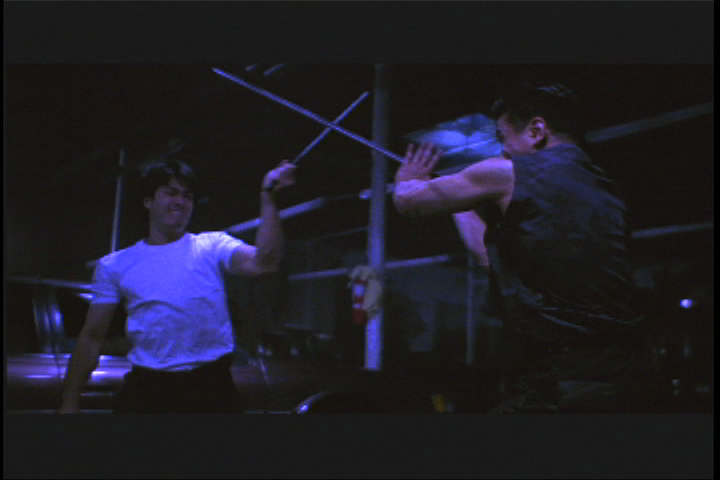|
|
The Making Of:
Shot in Boston, writer, director and producer Jason Yee set out to raise the bar in production value and entertainment for extreme-low budget movies. Inspired by classic film noir and detective movies, Jason wanted to make Edge of Darkness a dark murder mystery with Kung- Fu action. Jason knows all great films start with a strong script, which he had polished up until shooting had begun. The goal was to make an action/thriller with a Hollywood bang for less than the final budget of the drama Chasing Amy. This required precise shot planning, intense rehearsals, countless production meetings and many deferred contracts. Although this production team had a limited budget they were rich in resources and creative vigor. Jason Yee is also a renowned martial arts champion, which is where he got his courage and discipline to take on this complex project. Inspired by Clint Eastwood, Jason set lofty goals by planning to direct and star in the lead role. Jason said, “I had a clear vision for this film, I don’t want this to be seen as some vanity piece, because it’s not”. Aware of his own limitations and assets, Jason crafted a story precisely knowing what he could “pull-off”.
For several months during pre-production Jason meticulously outlined
his production plan and drew his own storyboards for the entire film
shot-for-shot with alternate plans giving allowance for time
constraints. Jason went to Robert Patton-Spruill, CEO of Filmshack
|
|
After viewing this film, one can see the bar in low-budget filmmaking was definitely taken to new heights. Edge of Darkness is truly an inspiration for the next generation of ambitious filmmakers.
Make-up artists apply stage blood to murdered victims at a crime scene. |
Cinematographer Stephen Maing
Jason Yee & Cung Le rehearse the films climatic final battle.
Shooting in real locations instead of sets made logistics more complex but, added realism to the films dramatic story. |
|
Final sword battle between Jason Yee and Cung Le. This was shot primarily hand-held, mixing S16mm & 35mm to add energy and save time.
Prison cell was the only artificial set in the film. Constructed of wood by Set Constructor Tony Pina, once painted and lit was totally convincing on film.
|
fine-tuned a concise production plan in order to succeed in this immensely complicated endeavor. They knew in order to achieve their budget goal they had to balance guerilla and professional film making tactics without getting arrested in the process. After interviewing several cinematographers Jason decided on the talented Stephen Maing for the job. Jason along with co-producers, Darrin Short Dawley and Joe Kelsey, set out to find exceptional cost-free locations, props, cars, wardrobe and actors. Jason’s mother, Karon Yee, catered the production. She provided home cooked meals for the entire cast and crew. This saved the production $20K. After months of planning, the cast and crew were ready for production.
Together, this native Boston production team, were Jason stated, “I wasn’t worried about simultaneously acting and directing, I was well prepared, I was more worried about getting hit in the face and screwing up the schedule.” Jason had to risk injury and first shoot complicated fight scenes with World champion fighter Cung Le. Jason knew there would be no time for fight rehearsals before each action scene. With such a tight schedule, fight rehearsals had to take place in preproduction. Cung Le arrived two weeks before shooting began, Jason and Cung needed to rehearse the fight routines right up until shooting, so they would be sharp for the camera.
|
|
by trained professionals like Cung Le and myself.” These action scenes took place in the film’s most grand locations such as: Boston’s largest night clubs, a car engine warehouse, large auto body shops and several night exteriors. This required a full lighting crew as well as grip/electric truck, which further complicated the logistics.
The first part of this fight sequence is my homage to the legendary Bruce Lee. Then, I take it to the next level and try to give The Matrix a run for their money, without the use of special effects. I only had two days to do this scene, Hollywood studio executives take note.” Executive producer Robert Patton-Spruill noted, “Jason is behind the camera, in front of the camera and does his own stunts, successfully!” Due to budget constraints Jason could not see the film dailies for several months. Jason noted, “The crew thought I was crazy because they didn’t know how the scenes would come together. Even though I didn’t see the footage, after finishing the first half of shooting, I knew it was a success.” The next leg of shooting took place over several months on weekends due to budget constraints. The production was stripped down to a skeleton crew. Filming took place in small interior locations; at times only the camera operator and cast could fit in the room. Jason‘s objective was to shoot a complicated chase scene involving a drive-by shooting, but there was no budget to shut down |
Storyboard concept drawings by Director Jason Yee come to life on film.
Director Jason Yee looks through the lens to check the framing of a shot. |
|
Theatrical Trailer Coming Soon email: comments@edgeofdarknessmovie.com
|





















